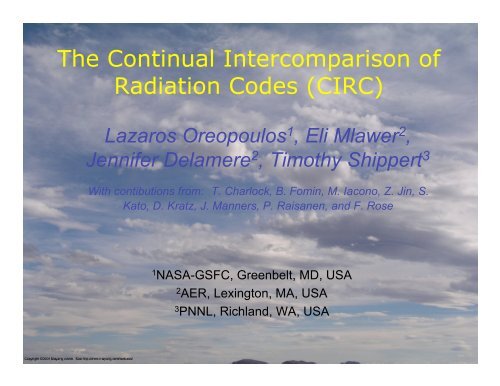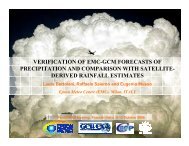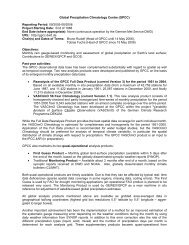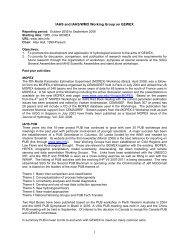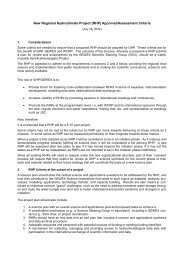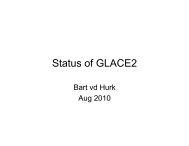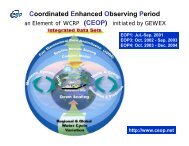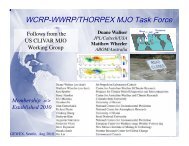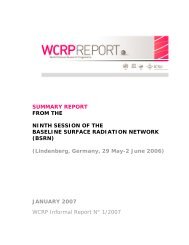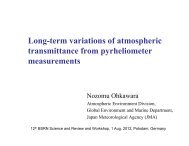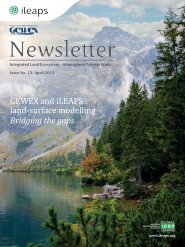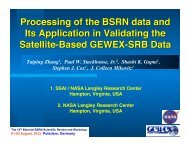The Continual Intercomparison of Radiation Codes (CIRC) - GEWEX
The Continual Intercomparison of Radiation Codes (CIRC) - GEWEX
The Continual Intercomparison of Radiation Codes (CIRC) - GEWEX
You also want an ePaper? Increase the reach of your titles
YUMPU automatically turns print PDFs into web optimized ePapers that Google loves.
<strong>The</strong> <strong>Continual</strong> <strong>Intercomparison</strong> <strong>of</strong><br />
<strong>Radiation</strong> <strong>Codes</strong> (<strong>CIRC</strong>)<br />
Lazaros Oreopoulos 1 , Eli Mlawer 2 ,<br />
Jennifer Delamere 2 , Timothy Shippert 3<br />
With contibutions from: T. Charlock, B. Fomin, M. Iacono, Z. Jin, S.<br />
Kato, D. Kratz, J. Manners, P. Raisanen, and F. Rose<br />
1<br />
NASA-GSFC, Greenbelt, MD, USA<br />
2<br />
AER, Lexington, MA, USA<br />
3<br />
PNNL, Richland, WA, USA
Historical Perspective (1)<br />
ICRCCM-I (1984 - 1991): InterComparison <strong>of</strong> <strong>Radiation</strong> <strong>Codes</strong> for<br />
Climate Models, WCRP/IRC)<br />
- LW: Ellingson and Fouquart (1991)<br />
-~60 idealized cases (mostly cloudless)<br />
- SW: Fouquart et al. (1991)<br />
-~60 idealized cases (again, mostly cloudless)<br />
- LBL vs. approximate models<br />
Overall message : for cloudless skies, errors can be alarmingly large<br />
LW
Historical Perspective (2)<br />
•ICRCCM-II (1991): SPECTRE (FIRE II)<br />
Emphasis on LW and cloudless skies<br />
Ellingson and Wiscombe (BAMS, 1996)<br />
Overall message : using observations to<br />
assess models can be fruitful, but is HARD<br />
... Genesis <strong>of</strong> the ARM program.
Historical Perspective (3)<br />
ICRCCM-III SW: (Barker et al. 2003)<br />
- Interpretation and handling <strong>of</strong> unresolved clouds<br />
- CSRM domains; benchmarks set by 3D MC codes<br />
-Compares 3D with PPH and ICA<br />
-Overall message : standard assumptions are <strong>of</strong>ten<br />
inadequate and no 1D single method is adequate for all.
Historical Perspective (4)<br />
ICRCCM-III LW: (IRC; Ellingson et al., ongoing)<br />
- Interpretation and handling <strong>of</strong> unresolved clouds<br />
-CSRM domains; benchmarks set by a 3D MC code<br />
-Compares 3D with PPH and ICA<br />
Overall message : TBD; So far, proven the inadequacy <strong>of</strong><br />
standard overlap assumptions<br />
solid: ICA<br />
dashed: MRO<br />
dotted: RO
Historical Perspective (5)<br />
RTMIP (RT Model <strong>Intercomparison</strong> Project, Collins et al., 2006<br />
- Focusing on well-mixed greenhouse gases<br />
- RT codes <strong>of</strong> IPCC AR4 GCMs<br />
- SW and LW with several LBL references<br />
Take home message : LBL codes agree, means <strong>of</strong> GCM codes<br />
good, but spread too wide (worse at the SFC for SW)<br />
2xCO2 forcing
So, what is the <strong>Continual</strong> <strong>Intercomparison</strong> <strong>of</strong><br />
<strong>Radiation</strong> <strong>Codes</strong> (<strong>CIRC</strong>)?<br />
• RT model intercomparison aspiring to become the standard for<br />
documenting the performance <strong>of</strong> RT codes used in Large-Scale Models<br />
• Supported by DOE’s ARM program and endorsed by GRP and IRC<br />
• Goal is to have RT codes <strong>of</strong> GCMs (incl. IPCC) report performance<br />
against <strong>CIRC</strong><br />
• Phase I was launched on June 4, 2008<br />
How <strong>CIRC</strong> differs from previous intercomparisons:<br />
• Observation-tested (LW) LBL calculations are used as radiative benchmarks<br />
• Benchmark results are publicly available<br />
• Observationally-based input (from an ARM product named BBHRP, mostly)<br />
• Flexible structure and longer lifespan than previous intercomparisons
<strong>CIRC</strong> website<br />
http://www.circ-project.org<br />
http://circ.gsfc.nasa.gov
Challenges we faced<br />
• For input and reference calculations to be credible, a reasonable level <strong>of</strong><br />
agreement with observations is desirable<br />
• Our designated data source (ARM BBHRP v.1.4.1) is small; very few<br />
BBHRP cases satisfy our criteria:<br />
homogeneous* (1D)<br />
closure at both SFC and TOA for both SW and LW<br />
• LBL calculations are not standard in BBHRP<br />
• Input for LBL calculations is not necessarily available from BBHRP (e.g.,<br />
spectral surface albedo)<br />
• Validation <strong>of</strong> LBL calculations<br />
• We nevertheless came up with a bunch <strong>of</strong> (semi-validated) cases<br />
* See also SPECTRE paper by Ellingson and Wiscombe (BAMS 1996)
<strong>CIRC</strong>’s main data source:<br />
BBHRP at SGP March 2000-February 2001<br />
daytime datapoints with TOA and SFC fluxes:<br />
375<br />
overcast liquid clouds:<br />
8<br />
appropriate for <strong>CIRC</strong><br />
(homogeneous, closure)<br />
1<br />
25<br />
SGP SW total at SFC<br />
Clear-sky cases: 150<br />
(~60 % have SZA > 60°)<br />
number <strong>of</strong> datapoints<br />
20<br />
15<br />
10<br />
5<br />
mean≈ – 2.5<br />
sdev≈ 6<br />
Direct component is for normal surface<br />
0<br />
-20 -15 -10 -5 0 5 10 15 20<br />
residual=obs-RRTM
<strong>CIRC</strong> Phase I cases<br />
Case<br />
SZA<br />
PWV<br />
(cm)<br />
τ aer<br />
LWP<br />
(gm -2 )<br />
LW SFC<br />
obs - LBL (%)<br />
LW TOA<br />
SW SFC<br />
SW TOA<br />
(1) SGP 9/25/00<br />
47.9°<br />
1.23<br />
0.04<br />
0.5<br />
-0.9<br />
0.5<br />
-3.1<br />
(2) SGP 7/19/00<br />
64.6°<br />
4.85<br />
0.18<br />
0.6<br />
-1.4<br />
-1.1<br />
8.4<br />
(3) SGP 5/4/00<br />
40.6°<br />
2.31<br />
0.09<br />
1.0<br />
-1.2<br />
-0.1<br />
-8.7<br />
(4, 5) NSA<br />
5/3/04 2xCO 2<br />
)<br />
55.1°<br />
0.29<br />
0.13<br />
1.2<br />
-0.6<br />
-0.8<br />
0.7<br />
(6) SGP 3/17/00<br />
45.5°<br />
1.90<br />
0.24<br />
263.4<br />
1.1<br />
-3.0<br />
4.9<br />
-0.9<br />
(7) PYE 7/6/05<br />
41.2°<br />
2.42<br />
39.1<br />
0.2<br />
0.6<br />
-0.4<br />
-0.1
LW QC: LBLRTM spectral comparisons with AERI<br />
10<br />
AERI-LBLRTM, Case 2<br />
radiance difference<br />
mW/(m -2 sr cm -1 )<br />
5<br />
0<br />
-5<br />
-10<br />
600 700 800 900 1000 1100 1200 1300 1400<br />
wavenumber (cm -1 )<br />
errors < 1 Wm -2
SW QC: Spectral comparison with RRTM<br />
sum (<br />
)<br />
≈ 0.14 Wm -2<br />
downwelling SFC<br />
sum ( )<br />
≈ 1.18 Wm -2<br />
upwelling TOA & SFC<br />
7/19/2000, SGP: Warm and moist
<strong>CIRC</strong> modus operandi (Phase I)<br />
• Input & output (TOA and SFC fluxes at 1 cm -1 ) and instructions on how to<br />
run the cases are openly available at the <strong>CIRC</strong> website<br />
• Only registered users (considered as formal participants) have privileges<br />
such as:<br />
e-mail notifications about changes, updates, and corrections to the <strong>CIRC</strong><br />
dataset.<br />
priority to participate in workshops and publications<br />
• Registered users may have to submit results within predetermined<br />
deadlines.<br />
• Submitted results and intercomparison analysis will be posted on website<br />
• Implementation details and performances <strong>of</strong> participating codes will be<br />
documented and evaluated
Phase I launch<br />
• Mass e-mail on June 4, 2008 (text available at <strong>CIRC</strong> website)<br />
• 17 requests to register as participants (7 USA, 2 Brazil, 2<br />
France, 2 Russia, 1 Australia, 1 Canada, 1 UK, 1 Finland)<br />
• 8 submissions received so far (a few more in the pipeline)<br />
• Feedback:<br />
o At IRC business meeting: absorb ICRCCM<br />
o Should not have publicized the reference results<br />
o More synthetic cases, please<br />
o SW heating rates, please<br />
o Remove aerosols<br />
o Separate species<br />
• Still fine-tuning and clarifying things<br />
• Please advertise, and if you have a code, participate!
Phase I initial results, flux errors<br />
% difference from LBL calculations<br />
10<br />
5<br />
0<br />
-5<br />
obs<br />
GSFC<br />
FLCKKR<br />
COART<br />
ES<br />
FMI<br />
LW downwelling flux at surface<br />
Case1 Case2 Case3 Case4 Case5 Case6 Case7<br />
% difference from LBL calculations<br />
4<br />
2<br />
0<br />
-2<br />
-4<br />
LW upwelling flux at TOA<br />
Case1 Case2 Case3 Case4 Case5 Case6 Case7<br />
-10<br />
10<br />
10<br />
SW upwelling flux at TOA<br />
% difference from LBL calculations<br />
5<br />
0<br />
-5<br />
Case1 Case2 Case3 Case4 Case 5 Case6 Case7<br />
% difference from LBL calculations<br />
5<br />
0<br />
-5<br />
Case1 Case2 Case3 Case4 Case 5 Case6 Case7<br />
-10<br />
SW total downwelling flux at SFC<br />
31%<br />
-10<br />
FLCKKR (= Fu, Liou Charlock, Kato, Kratz, Rose), submitted by Rose and Charlock<br />
COART (= Coupled Ocean-Atmosphere Radiative Transfer), submitted by Jin and Charlock<br />
ES (= Edwards-Slingo), submitted by Manners<br />
FMI (=Finnish Meteorological Institute), submitted by Räisänen
CAM3 RT vs. RRTMG<br />
5<br />
4<br />
LW down SFC<br />
obs<br />
CAM<br />
RRTMG<br />
2<br />
1<br />
% deviation from LBLRTM<br />
3<br />
2<br />
1<br />
% deviation from LBLRTM<br />
0<br />
-1<br />
-2<br />
-3<br />
0<br />
-4<br />
-1<br />
Case1 Case2 Case3 Case4 Case5 Case6 Case7<br />
-5<br />
LW up TOA<br />
Case1 Case2 Case3 Case4 Case5 Case6 Case7<br />
8<br />
SW down SFC<br />
10<br />
% deviation from CHARTS<br />
6<br />
4<br />
2<br />
0<br />
% deviation from CHARTS<br />
5<br />
0<br />
-5<br />
-2<br />
Case1 Case2<br />
Case3 Case4 Case 5 Case6 Case7<br />
-10<br />
Case1 Case2<br />
SW up TOA<br />
Case3 Case4 Case 5 Case6 Case7
Phase I preliminary results, heating rates<br />
p(hPa)<br />
0.1<br />
1<br />
10<br />
100<br />
LW, case2, moist<br />
1000<br />
-15 -10 -5 0 5<br />
heating rate (K/day)<br />
0.1<br />
SW, case2<br />
p(hPa)<br />
1<br />
10<br />
100<br />
RRTM<br />
LBLf<br />
1000<br />
0 5 10 15 20<br />
heating rate (K/day)<br />
p(hPa)<br />
p(hPa)<br />
0<br />
200<br />
400<br />
600<br />
800<br />
RRTM<br />
LBLf<br />
LBLRTM<br />
LW, case6, thick cloud<br />
1000 -15 -10 -5 0 5<br />
0<br />
200<br />
400<br />
600<br />
800<br />
heating rate (K/day)<br />
SW, case6<br />
1000 0 5 10 15 20<br />
heating rate (K/day)<br />
Note: No reference SW HR available from CHARTS
Importance <strong>of</strong> spectral surface albedo<br />
CHARTS weighted-SSF weighted sfc. albedo<br />
CHARTS-R sfc<br />
NIR<br />
(3)=0.299<br />
SSF-R sfc<br />
NIR<br />
(3)=0.274<br />
CHARTS-R sfc<br />
NIR<br />
(4)=0.514<br />
SSF-R sfc<br />
NIR<br />
(4)=0.471<br />
flux difference (Wm -2 )<br />
15<br />
10<br />
5<br />
0<br />
TOA upwelling<br />
GSFC<br />
CAM<br />
ES<br />
}<br />
Resolve sfc<br />
albedo into<br />
2 bands<br />
Resolves<br />
sfc albedo<br />
into 6 bands<br />
-5<br />
Case1 Case2<br />
Case3 Case4 Case 5 Case6 Case7
Phase I initial results, CO 2 forcing <strong>of</strong> dry atmospheres<br />
SW or LW forcing (Wm -2 )<br />
4<br />
3<br />
2<br />
1<br />
0<br />
-1<br />
-2<br />
-3<br />
-4<br />
LBL<br />
SW<br />
LW<br />
GSFC<br />
CAM<br />
FLCKKR<br />
COART<br />
FMI<br />
ES<br />
SFC<br />
RRTMG<br />
CHARTS-R sfc<br />
NIR<br />
(4)=0.514<br />
CHARTS-R sfc<br />
NIR<br />
(5)=0.516<br />
FLCKKR and COART<br />
have fixed CO 2<br />
in SW<br />
SW or LW forcing (Wm -2 )<br />
2<br />
1.5<br />
1<br />
0.5<br />
0<br />
-0.5<br />
TOA<br />
-1<br />
Case4-Case5 (double CO2 experiment)
CO 2 forcing net flux pr<strong>of</strong>ile differences<br />
0<br />
SW<br />
0<br />
LW<br />
200<br />
200<br />
p(hPa)<br />
400<br />
600<br />
p(hPa)<br />
400<br />
600<br />
800<br />
1000<br />
800<br />
1000<br />
CAM<br />
GSFC<br />
ES<br />
RRTM<br />
-0.5 0 0.5 1 1.5 2 2.5<br />
flux difference (Wm -2 )<br />
0 1 2 3 4 5<br />
flux difference (Wm -2 )
CO 2 spectral forcing<br />
TOA or SFC forcing (Wm -2 /cm -1 )<br />
0.04<br />
0.02<br />
0<br />
-0.02<br />
Case4-Case5<br />
TOA up<br />
SFC down<br />
thermal<br />
-0.04<br />
2xCO<br />
2<br />
spectral forcing<br />
SFC forcing (Wm -2 /cm -1 )<br />
0.005<br />
0.004<br />
0.003<br />
0.002<br />
0.001<br />
600 800 1000 1200 1400<br />
wavenumber (cm -1 )<br />
Case4-Case5, down SFC<br />
solar<br />
0<br />
2000 4000 6000 8000 1 10 4<br />
wavenumber (cm -1 )
<strong>CIRC</strong> activities and future<br />
• Talks at IRS’08 and ARM’08 WG meetings<br />
• Extended abstract to appear in IRS’08 proceedings<br />
• Short (“Nowcast”) BAMS article submitted<br />
• ARM proposal seeking funding for Phase II (ice clouds, SW<br />
spectral closure) pending<br />
• “Pristine” and “cloudless” (Cases 6 & 7) versions will soon be<br />
released<br />
• Would like to see submission from RT codes used for global<br />
flux datasets<br />
• Workshop within 2009 (after GRC on <strong>Radiation</strong> & Climate?)<br />
• Standards, certification, funding?


